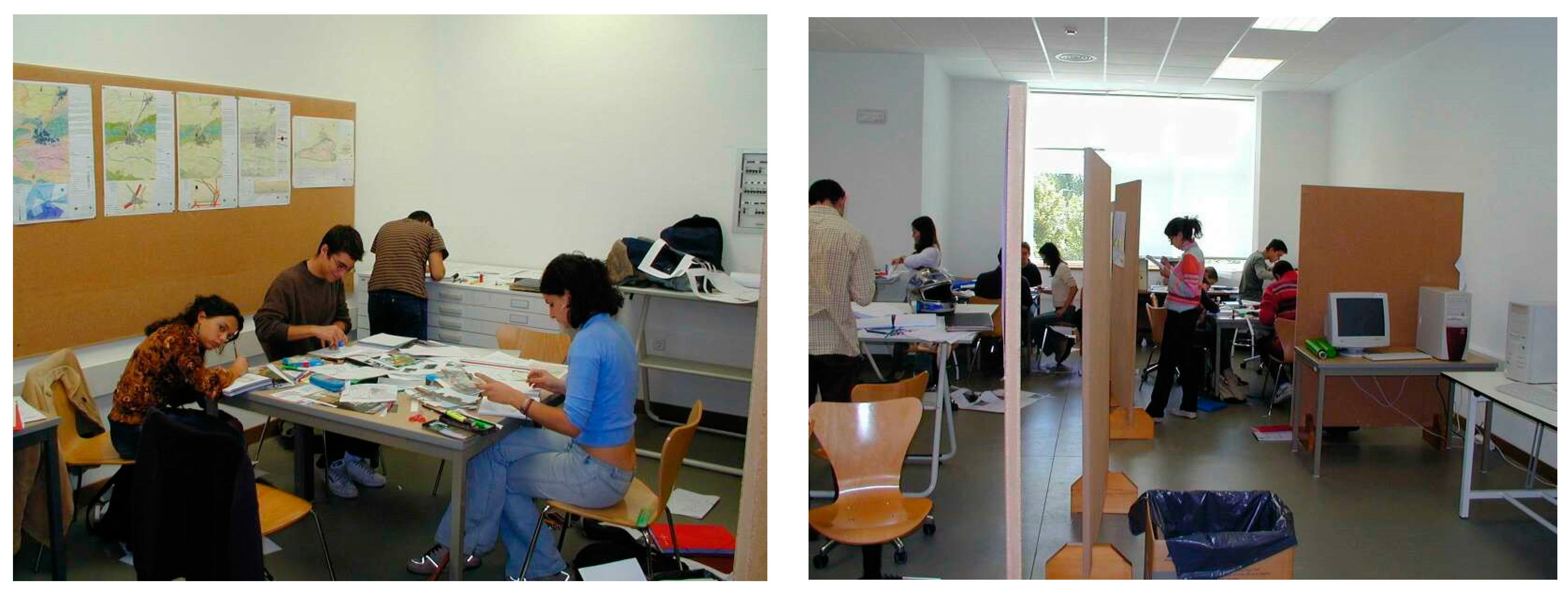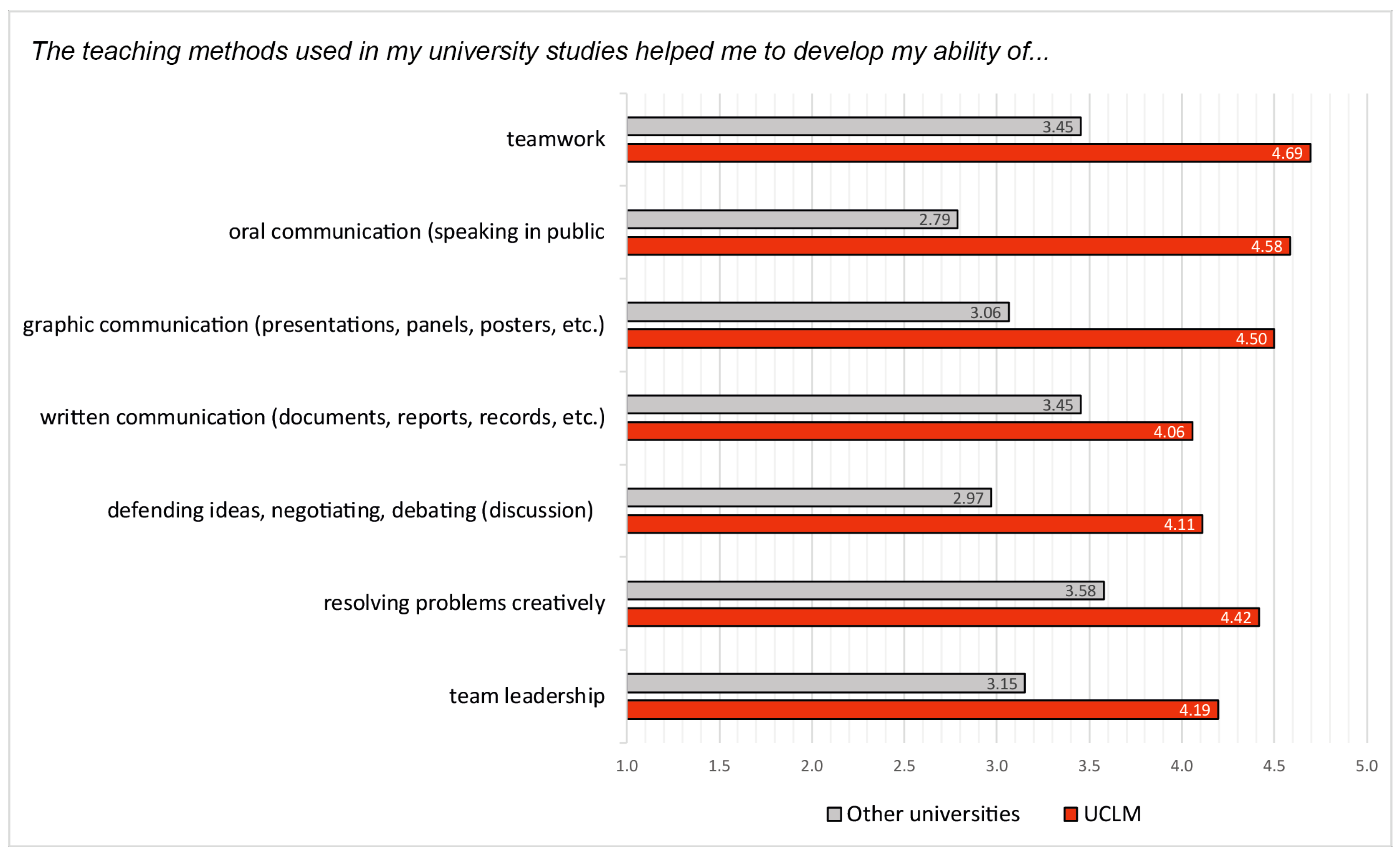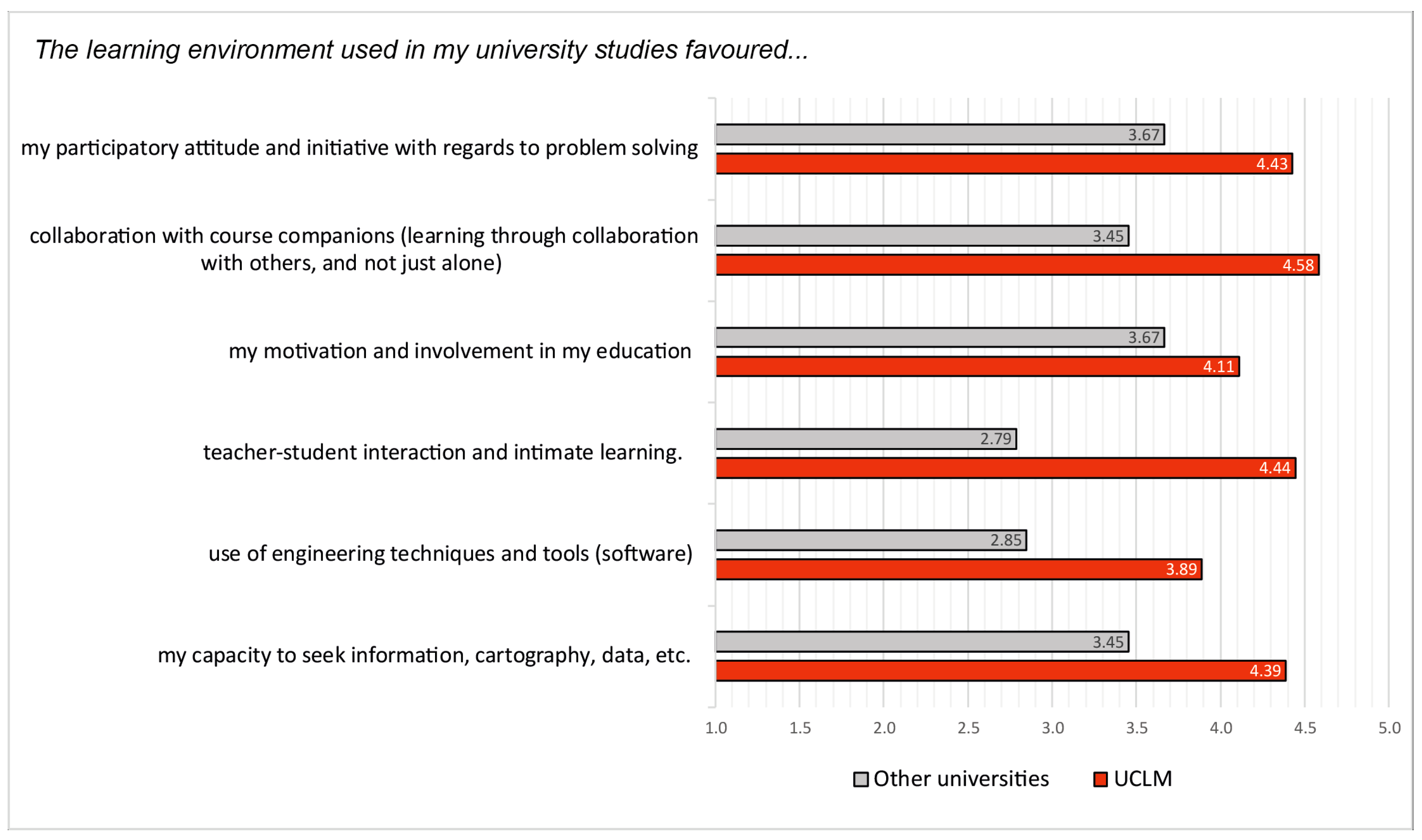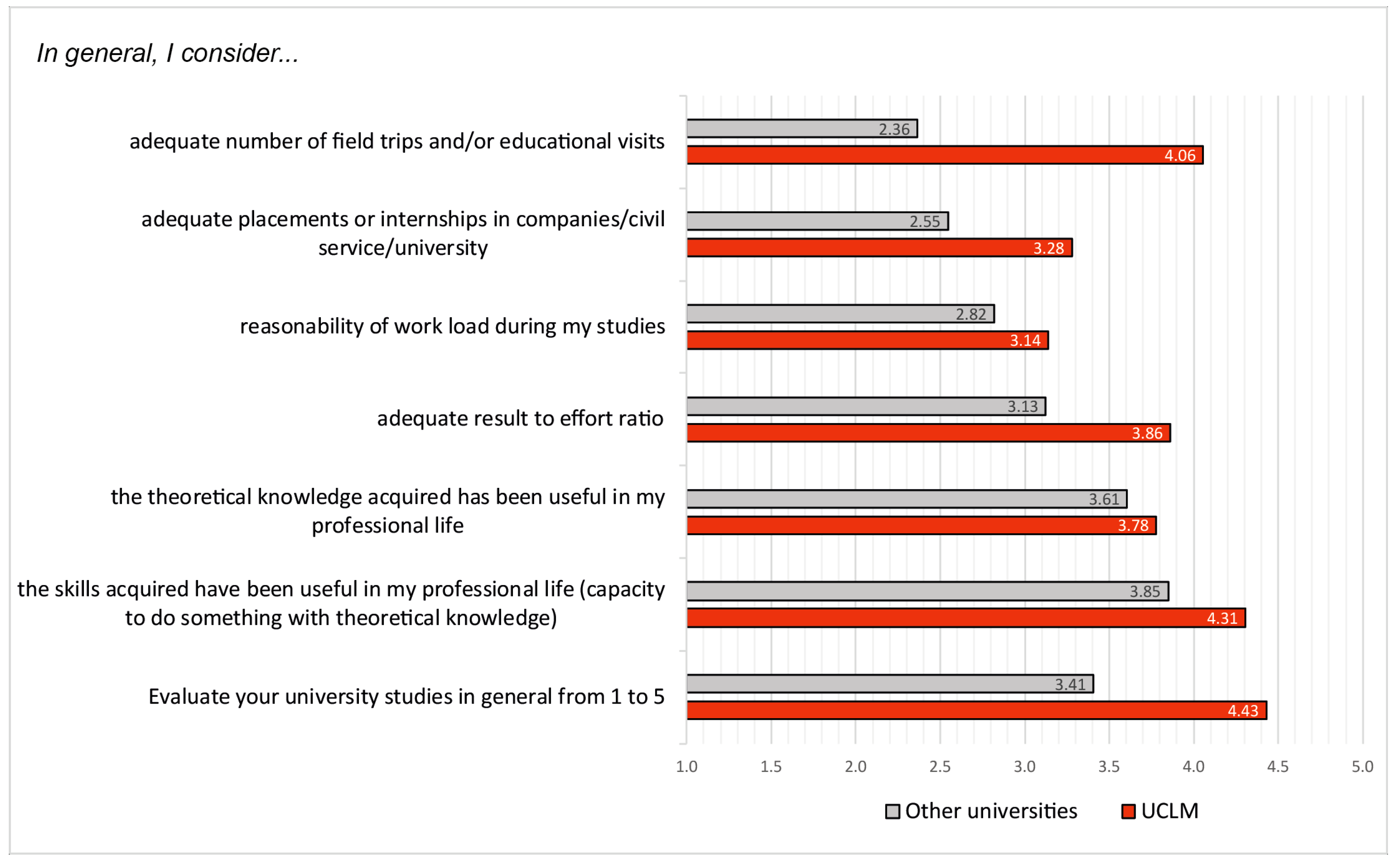Student Long-Term Perception of Project-Based Learning in Civil Engineering Education: An 18-Year Ex-Post Assessment
Abstract
1. Introduction
2. PjBL in Civil Engineering
2.1. Key Aspects of PjBL Methodology
2.2. Implementation of PjBL in Civil Engineering Education
3. PjBL Curriculum in Civil Engineering in UCLM
- To introduce students to an active learning environment. Spanish engineering graduates had good abstract knowledge but they were passive and had poor entrepreneurial capabilities, which could be related to the traditional learning environment in which they had developed their studies.
- To introduce students to team activity. In Spain, most learning activities were individual. Students received many lectures (more than 25 h per week), went home, and studied what the professor explained with little contact with their classmates and making scarce use of the university facilities and libraries. In professional work, the majority of the activities are carried out in teams, making extensive use of the materials and facilities available.
- To get students in early contact with engineering-related topics. In Spain, most civil engineering curricula devote the first two years to basic sciences (e.g., mathematics, physics, chemistry, drawing, materials science, fluid mechanics). PjBL activities allow students early contact with quasi-real engineering activities [21].
- To introduce students to an evaluation framework in which the response to questions are not sectorial, unique, or exact. In Spain, the evaluation of engineering courses was mainly done through written exams with subject-specific questions requiring single and exact answers. In engineering, there are no categorical, single, and exact solutions; on the contrary, there are always several options, with different advantages and disadvantages for each multidisciplinary problem.
4. Evaluation of Graduate Perception of PjBL Methodology
4.1. Evaluation Method
4.2. Results
4.2.1. Personal Skills
- The most highly valued aspect of UCLM graduates, not just in relation to this section but in terms of the entire survey, was the capacity to work on a team (4.69), which demonstrates the use of PjBL to develop this capacity, as all the project work was developed in teams of between 3 and 5 students and, furthermore, this methodology was extended to other subjects. This appraisal was backed up by the second answer in the following section in which the respondents were asked about collaborative learning. For their part, the reference population also awarded a relative high appraisal (3.45; mode 3) though with a greater spread, which shows that they performed group activities, such as projects, works, etc., and, at the very least, studying and resolving problems in groups with colleagues.
- With regards to oral communication skills, the fact that each project work included a final oral defense, in addition to various partial defenses, meant that UCLM were capable of developing these skills and this was duly acknowledged in the survey (4.58). The difference with respect to the reference population was broadened here as the latter group gave this a lower ranking that did not even reach a pass (2.79), and where mode 1 appeared with a frequency of 27%. In fact, this was the only answer to have mode 1 other than that concerning company internships, which goes to demonstrate the serious learning weaknesses with respect to oral communication of Spanish universities at that time, due to the predominance of traditional lecture-based methods.
- Two questions related to oral communication and group work, such as the capacity to defend ideas, negotiate, and debate, as well as that regarding group leadership, also revealed large differences between the UCLM students (4.11 and 4.19) and their mirror group (2.97 and 2.15), though the average values of the UCLM graduates were somewhat lower than in the previous answers, as there was a greater diversity of answers. This would seem to indicate that while PjBL encourages the development of these skills (which was recognized as such by the students), it is not equally effective for everyone. This, in our experience, comes down to personal differences in character at the outset. When there is one student in the group with greater leadership skills and/or higher intelligence, this can restrict the development of these skills within the rest of the group, who let themselves be led by the leader, and similarly reduces debate and discussion among the group.
- With regards to graphic communication skills, the difference was also high (4.5 opposed to 3.06), as all the project work conducted throughout all the courses required the preparation of diagrams, sketches, plans, and panels to resolve the project. To the contrary, in the traditional focus of the engineering colleges, drawing, and draughtsmanship is only given in the first years and their content tends to be abandoned or even forgotten before ending the studies. However, the difference remained small in terms of written communication skills (4.06 as opposed to 3.45), as these skills were more common under traditional teaching methods.
4.2.2. Learning Environment
- The largest difference between both populations, as was expected, was the teacher–student relationship (4.44 vs. 2.79). The response revealed the huge gap between the UCLM Civil Engineering college, with reduced groups and PjBL, and the rest of the Spanish universities, where groups may reach up to 200–300 students and where PjBL is barely used.
- However, with regards to the motivation and involvement of the student, the differences narrowed (4.11 vs. 3.67), as the difficulty of engineering degrees means that students, regardless of teaching method, always have a high level of motivation and involvement. This positive attitude of the students was confirmed by the question related to their participatory attitude and initiative to resolve problems and where the very high values of UCLM students (4.43) were almost matched by the value of the reference population (3.67).
- The aspect most highly appraised by UCLM students was that of collaborative learning or learning from others (4.58 vs. 3.45), and this, as we have already forwarded, is one of the most positive aspects of PjBL and one that is readily confirmed by the survey.
- While there was a large difference between the responses of the two populations in terms of learning environment, both gave their lowest scores to the use of engineering software (3.89 vs. 2.85), which demonstrates the difficulty universities have in equipping themselves and keeping updated in this respect, regardless of the teaching methodology employed.
4.2.3. Types of Projects Resolved
- UCLM graduates clearly identified that the projects they had resolved were complex and did not have a single solution and gave this aspect one of the highest scores of all the questions (4.64), only exceeded by that regarding the capacity to work in groups. The difference between UCLM graduates and the reference population was nigh on one point in this respect (3.66).
- The largest difference between both populations was with respect to the possibility of visiting project sites (4.61 vs. 2.97). One of the characteristics of project work at UCLM is the incorporation of site visits, among other aspects. However, at Spanish universities in general, and with the large groups involved, it is difficult and fairly uncommon to make field trips and site visits and it is normal that this is a failing that was recognized by this student population.
- To the contrary, the gaps between both populations narrowed with respect to the practical application of theory (4.47 vs. 3.76) and the real and professional nature of projects and training (4.36 vs. 3.61), which would appear logical as the teaching of engineering is practical and applied by definition, regardless of the teaching method employed. For this reason, both populations considered the need for continuous learning throughout their professional lives (4.36 vs. 3.55).
4.2.4. General Aspects
- Both populations were equally satisfied with the theoretical knowledge acquired and its use (3.78 and 3.61), which shows that the time employed in practical work by PjBL was not perceived by graduates as a loss of theoretical knowledge. With regards to practical skills, the ability to apply theoretical knowledge was positively appraised by both populations (4.31 vs. 3.85) though the difference in favor of UCLM grew slightly.
- The greatest difference in favor of UCLM in this section of the survey were with respect to the adequate number of field trips (4.06 vs. 2.36), which as commented earlier was one of the strong points of UCLM and one of the weak points of Spanish universities.
- The differences were also large, though to a somewhat lesser extent, with regard to company placements or internships (3.28 vs. 2.55). At the time the UCLM had a non-compulsory extracurricular internship program in place, and in many cases it was up to the student to do training or not. For this reason, the spread in the response was easily the largest (variation of 1.8). In all events, the merit of internships/placements was demonstrated in the answers of both populations because many of the UCLM graduates found their first employment through the same, as indicated in the previous section. It is of note that the current degree and master programs in civil engineering at the UCLM includes curricular placements.
- The responses given with respect to the reasonability of the workload were found to be low for both populations (3.13 vs. 2.82), which demonstrates the high demands on engineering undergraduates in Spain. However, while the effort required is high for everyone, UCLM graduates were far more appreciative of the result to effort ratio than the reference population who were more negative in this regard (3.86 vs. 2.82). This demonstrates that PjBL helps to make the efforts of the student more effective and allows them to develop skills that are positively appraised in the workplace, as shown by the survey.
5. Conclusions
Author Contributions
Funding
Conflicts of Interest
References
- Quinn, K.A.; Albano, L.D. Problem-based learning in structural engineering education. J. Prof. Issues Eng. Educ. Pract. 2008, 134, 329–334. [Google Scholar] [CrossRef]
- Rodrigues Da Silva, A.N.; Kuri, N.P.; Casale, A. PBL and B-learning for civil engineering students in a transportation course. J. Prof. Issues Eng. Educ. Pract. 2012, 138, 305–313. [Google Scholar] [CrossRef]
- Li, M.; Faghri, A. Applying Problem-Oriented and Project-Based Learning in a Transportation Engineering Course. J. Prof. Issues Eng. Educ. Pract. 2016, 142. [Google Scholar] [CrossRef]
- El-Adaway, I.; Pierrakos, O.; Truax, D. Sustainable construction education using problem-based learning and service learning pedagogies. J. Prof. Issues Eng. Educ. Pract. 2015, 141. [Google Scholar] [CrossRef]
- Gratchev, I.; Jeng, D.S. Introducing a project-based assignment in a traditionally taught engineering course. Eur. J. Eng. Educ. 2018, 43, 788–799. [Google Scholar] [CrossRef]
- Williams, K.; Pender, G. Problem-based learning approach to construction management teaching. J. Prof. Issues Eng. Educ. Pract. 2002, 128, 19–24. [Google Scholar] [CrossRef]
- Murray, M.; Hendry, G.; McQuade, R. Civil Engineering 4 Real (CE4R): Co-curricular learning for undergraduates. Eur. J. Eng. Educ. 2019. [Google Scholar] [CrossRef]
- Mills, J.E.; Treagust, D.F. Engineering Education—Is Problem-Based or Project-Based Learning the Answer? Australas. J. Eng. Educ. 2003, 3. [Google Scholar] [CrossRef]
- Kwan, C.L. Findings from the implementation of project-based learning in civil engineering education. SHS Web Conf. 2016, 26, 01016. [Google Scholar] [CrossRef]
- Hadgraft, R. Student reactions to a problem-based, fourth-year computing elective in civil engineering. Eur. J. Eng. Educ. 1997, 22, 115–123. [Google Scholar] [CrossRef]
- De Camargo Ribeiro, L.R.; Mizukami, M.D.G.N. Student assessment of a problem-based learning experiment in civil engineering education. J. Prof. Issues Eng. Educ. Pract. 2005, 131, 13–18. [Google Scholar] [CrossRef]
- Gavin, K. Case study of a project-based learning course in civil engineering design. Eur. J. Eng. Educ. 2011, 36, 547–558. [Google Scholar] [CrossRef]
- El-Maaddawy, T.; El-Hassan, H.; Jassmi, H. Al Student perceptions of the use of project-based learning in civil engineering courses. In Proceedings of the IEEE Global Engineering Education Conference, EDUCON, Santa Cruz de Tenerife, Spain, 18–20 April 2018. [Google Scholar]
- Kjersdam, F.; Enemark, S. The Aalborg Experiment: Project Innovation in University Education; Aalborg University Press: Aalborg, Denmark, 1994. [Google Scholar]
- Kolmos, A.; Fink, F.K.; Krogh, L. The Aalborg PBL model-Progress, Diversity and Challenges Introduction The Aalborg Model—Problem-Based and Project-Organized Learning; Aalborg University: Aalborg, Denmark, 2004. [Google Scholar]
- De Graaff, E.; Kolmos, A. Characteristics of Problem-Based Learning. Int. J. Eng. Educ. 2003, 19, 657–662. [Google Scholar]
- Bratteland, E.; Hjelsth, E. PBL: Introducing Civil Engineering at NTNU—Collaboration, experiences and evaluation. Management 2003, 5, 2. [Google Scholar]
- Medina, P.; Guisado, P. Qué Estudiar y Dónde Para Tener las Mejores Perspectivas Laborales. Available online: https://www.elmundo.es/especiales/educacion/empleo-universidad.html (accessed on 20 August 2015).
- De Ureña, J. Proyecto de nueva Escuela de Ingenieros de Caminos, Canales y Puertos en Ciudad Real. Rev. Obras Públicas 1998, 145, 11–20. [Google Scholar]
- De Ureña, J.M.; Menéndez, J.M.; Coronado, J.M. Project/Problem Based Learning in Civil Engineering: The Ciudad Real (Spain) Experience. In Proceedings of the International Conference on Engineering Education, Valencia, Spain, 21–25 July 2003; pp. 1–8. [Google Scholar]
- Gordon, R. Balancing Real-World Problems with Real-World Results. Phi Delta Kappan 1998, 79, 390–393. [Google Scholar]
- Coronado, J.M.; Ribalaygua, C. Docencia basada en Proyectos (PBL) en una Escuela de Ing. de Caminos: Experiencia del 1er trabajo proyectual. In Proceedings of the II Congreso Internacional Docencia Universitaria e Innovación, Tarragona, Spain, 1–3 July 2002; pp. 1–18. [Google Scholar]
- Coronado, J.; de Ureña, J.; Garmendia, M. La Metodología PBL aplicada a la docencia del Urbanismo y Ordenación del Territorio: El trabajo proyectual “desarrollo urbano y Territorial”. In Proceedings of the III Encuentro de intercambio de experiencias de innovación docente, Ciudad Real, Spain, 30 June 2007. [Google Scholar]
- Aparicio, A.C.; Ruiz-Teran, A.M. Tradition and innovation in teaching structural design in civil engineering. J. Prof. Issues Eng. Educ. Pract. 2007. [Google Scholar] [CrossRef]
- Castillo, E.; Coronado, J.M.; Gálvez, J.; Ruiz, G.; Sanz, A.; Simarro, G.; Solares, C.; Spaliviero, F.; Ureña, J.M. Los Trabajos Proyectuales en la formación del Ingeniero de Caminos: Una alternativa integradora. In Proceedings of the III Congreso Nacional de Ingeniería Civil, Barcelona, Spain, 24–26 November 1999; pp. 1429–1434. [Google Scholar]
- Paje, S.E.; Bueno, M.; Luong, J. Fundamentals of Physics for the Civil Engineering Degree: Problem Based Learning (PBL). In Proceedings of the INTED2011, the 5th International Technology, Education and Development Conference, Valencia, Spain, 7–9 March 2011. [Google Scholar]
- López-Querol, S.; Sánchez-Cambronero, S.; Rivas, A.; Garmendia, M. Improving civil engineering education: Transportation geotechnics taught through project-based learning methodologies. J. Prof. Issues Eng. Educ. Pract. 2015. [Google Scholar] [CrossRef]
- Ruiz, R.; Moyano, A.; Romero De Ávila, V.; Coronado, J.M.; Rodríguez, J. Heritage Preservation Training in Civil Engineering Education: Modern Roads Restoration Projects. J. Prof. Issues Eng. Educ. Pract. 2018, 144. [Google Scholar] [CrossRef]
- Castillo, C.; Galán, Á.; González, J.; Rodríguez, L. Introducing Project Management Processes and Skills on a PBL Subject. In Proceedings of the IV International Conference on Civil Engineering Education EUCEET 2018, Barcelona, Spain, 5–8 September 2018; pp. 1–5. [Google Scholar]
- Bell, S.; Galilea, P.; Tolouei, R. Student experience of a scenario-centred curriculum. Eur. J. Eng. Educ. 2010, 35, 235–245. [Google Scholar] [CrossRef]
- Heckathorn, D.D. Respondent-driven sampling: A new approach to the study of hidden populations. Soc. Probl. 1997, 44, 174–199. [Google Scholar] [CrossRef]
- Verdery, A.M.; Mouw, T.; Bauldry, S.; Mucha, P.J. Network structure and biased variance estimation in respondent driven sampling. PLoS ONE 2015, 10. [Google Scholar] [CrossRef] [PubMed]
- Gile, K.J.; Handcock, M.S. Respondent-Driven Sampling: An Assessment of Current Methodology. Sociol. Methodol. 2010, 40, 285–327. [Google Scholar] [CrossRef] [PubMed]






| Year | Compulsory Courses | Optional Courses | Number of Projects | PjBL % of Student Time | Project Theme | |
|---|---|---|---|---|---|---|
| 1st Semester | 2nd Semester | |||||
| 1st | 10 | 0 | 0 | 0 | --- | --- |
| 2nd | 8 | 0 | 2 | 25 | Road related environment | Water-related environment |
| 3rd | 6 | 1 | 2 | 32 | Land-use urban planning | Transportation |
| 4th | 6 | 1 | 2 | 32 | Structures | Hydraulic infrastructure |
| 5th | 4 | 5 | 1 | 17 | Final Project (individual) | |
| QUESTION | UCLM | Other Univ | Difference | VAR UCLM | VAR Others | DIFERENCE VAROthers-UCLM | Mode UCLM | % Mode Freq. UCLM | Mode others | % Mode Freq. Others | |
|---|---|---|---|---|---|---|---|---|---|---|---|
| The teaching methods used in my university studies helped me to develop my ability of… | |||||||||||
| METHOD | …teamwork | 4.69 | 3.45 | 1.24 | 0.275 | 1.256 | 0.980 | 5 | 75% | 3 | 33% |
| …oral communication (speaking in public | 4.58 | 2.79 | 1.80 | 0.364 | 1.985 | 1.621 | 5 | 60% | 1 | 27% | |
| …graphic communication (presentations, panels, posters, etc.) | 4.50 | 3.06 | 1.44 | 0.543 | 1.609 | 1.066 | 5 | 58% | 3 | 33% | |
| …written communication (documents, reports, records, etc.) | 4.06 | 3.45 | 0.60 | 0.797 | 1.693 | 0.896 | 4 | 44% | 4 | 41% | |
| …defending ideas, negotiating, debating (discussion) | 4.11 | 2.97 | 1.14 | 0.730 | 1.530 | 0.800 | 5 | 40% | 2 | 29% | |
| …resolving problems creatively | 4.42 | 3.58 | 0.84 | 0.421 | 1.502 | 1.080 | 5 | 50% | 4 | 37% | |
| …team leadership | 4.19 | 3.15 | 1.04 | 0.504 | 1.695 | 1.191 | 4 | 54% | 3 | 45% | |
| The learning environment used in my university studies favored… | |||||||||||
| ENVIRONMENT | …my participatory attitude and initiative with regards to problem solving | 4.43 | 3.67 | 0.76 | 0.487 | 1.292 | 0.804 | 5 | 52% | 4 | 43% |
| …collaboration with course companions (learning through collaboration with others, and not just alone). | 4.58 | 3.45 | 1.13 | 0.364 | 1.506 | 1.141 | 5 | 60% | 4 | 39% | |
| …my motivation and involvement in my education | 4.11 | 3.67 | 0.44 | 0.787 | 0.917 | 0.129 | 4 | 46% | 4 | 45% | |
| …teacher–student interaction and intimate learning. | 4.44 | 2.79 | 1.66 | 0.425 | 1.985 | 1.559 | 5 | 56% | 2 | 31% | |
| …use of engineering techniques and tools (software) | 3.89 | 2.85 | 1.04 | 0.959 | 1.195 | 0.236 | 4 | 42% | 3 | 33% | |
| …my capacity to seek information, cartography, data, etc. | 4.39 | 3.45 | 0.93 | 0.587 | 1.256 | 0.668 | 5 | 48% | 4 | 47% | |
| During my studies, I frequently faced the resolution of problems/practices/projects… | |||||||||||
| PROJECT | …complex and open solution (not one solution) | 4.64 | 3.66 | 0.98 | 0.352 | 1.394 | 1.043 | 5 | 67% | 4 | 39% |
| …requiring the reaching of different, and often contradictory, objectives | 4.22 | 3.42 | 0.80 | 0.692 | 1.064 | 0.372 | 5 | 42% | 4 | 37% | |
| …enabling the practical application of theoretical knowledge | 4.47 | 3.76 | 0.71 | 0.599 | 1.002 | 0.403 | 5 | 56% | 4 | 43% | |
| …that included a multidisciplinary focus (with content from various subjects) | 4.33 | 3.50 | 0.83 | 0.514 | 1.613 | 1.099 | 5 | 46% | 4 | 43% | |
| …of real and professional nature | 4.36 | 3.61 | 0.76 | 0.466 | 1.059 | 0.593 | 4 | 42% | 4 | 45% | |
| …in specific places and situations that could be visited, studied and understood in-situ, etc. | 4.61 | 2.97 | 1.64 | 0.473 | 1.218 | 0.745 | 5 | 62% | 4 | 33% | |
| …that helped me understand the need for continuous learning throughout my professional life | 4.36 | 3.55 | 0.82 | 0.637 | 1.443 | 0.806 | 5 | 48% | 3 | 31% | |
| GENERAL | In general, I consider… | ||||||||||
| …adequate number of field trips and/or educational visits | 4.06 | 2.36 | 1.69 | 0.797 | 1.114 | 0.317 | 4 | 42% | 2 | 31% | |
| …adequate placements or internships in companies/civil service/university | 3.28 | 2.55 | 0.73 | 1.806 | 1.631 | −0.176 | 4 | 25% | 1 | 31% | |
| …reasonability of workload during my studies | 3.14 | 2.82 | 0.32 | 1.380 | 1.466 | 0.086 | 2 | 35% | 2 | 33% | |
| …adequate result to effort ratio | 3.86 | 3.13 | 0.74 | 0.809 | 1.145 | 0.336 | 4 | 42% | 3 | 31% | |
| …the theoretical knowledge acquired has been useful in my professional life | 3.78 | 3.61 | 0.17 | 1.092 | 0.996 | −0.096 | 4 | 44% | 4 | 43% | |
| …the skills acquired have been useful in my professional life (capacity to do something with theoretical knowledge) | 4.31 | 3.85 | 0.46 | 0.675 | 0.945 | 0.270 | 4 | 50% | 4 | 43% | |
| Evaluate your university studies in general from 1 to 5 | 4.43 | 3.41 | 1.02 | 0.311 | 0.830 | 0.519 | 4 | 52% | 4 | 45% | |
Publisher’s Note: MDPI stays neutral with regard to jurisdictional claims in published maps and institutional affiliations. |
© 2021 by the authors. Licensee MDPI, Basel, Switzerland. This article is an open access article distributed under the terms and conditions of the Creative Commons Attribution (CC BY) license (http://creativecommons.org/licenses/by/4.0/).
Share and Cite
Coronado, J.M.; Moyano, A.; Romero, V.; Ruiz, R.; Rodríguez, J. Student Long-Term Perception of Project-Based Learning in Civil Engineering Education: An 18-Year Ex-Post Assessment. Sustainability 2021, 13, 1949. https://doi.org/10.3390/su13041949
Coronado JM, Moyano A, Romero V, Ruiz R, Rodríguez J. Student Long-Term Perception of Project-Based Learning in Civil Engineering Education: An 18-Year Ex-Post Assessment. Sustainability. 2021; 13(4):1949. https://doi.org/10.3390/su13041949
Chicago/Turabian StyleCoronado, José M., Amparo Moyano, Vicente Romero, Rita Ruiz, and Javier Rodríguez. 2021. "Student Long-Term Perception of Project-Based Learning in Civil Engineering Education: An 18-Year Ex-Post Assessment" Sustainability 13, no. 4: 1949. https://doi.org/10.3390/su13041949
APA StyleCoronado, J. M., Moyano, A., Romero, V., Ruiz, R., & Rodríguez, J. (2021). Student Long-Term Perception of Project-Based Learning in Civil Engineering Education: An 18-Year Ex-Post Assessment. Sustainability, 13(4), 1949. https://doi.org/10.3390/su13041949








